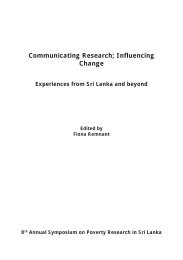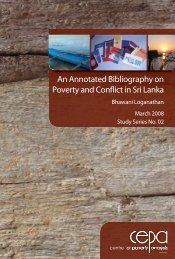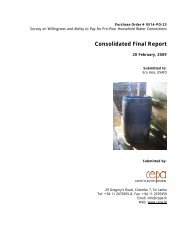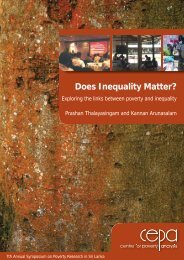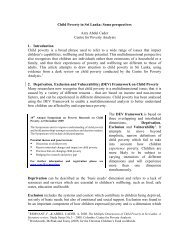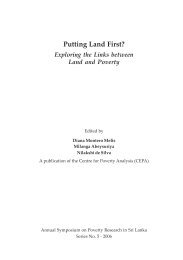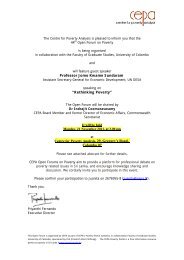Involuntary Displacement and Resettlement â Policy and ... - CEPA
Involuntary Displacement and Resettlement â Policy and ... - CEPA
Involuntary Displacement and Resettlement â Policy and ... - CEPA
- No tags were found...
Create successful ePaper yourself
Turn your PDF publications into a flip-book with our unique Google optimized e-Paper software.
qualitative data collected from focus group discussions <strong>and</strong> key informantinterviews is used to get an in-depth underst<strong>and</strong>ing of the issues.The findings of this paper reveal that post-tsunami interventions to providehousing, restore livelihoods <strong>and</strong> improve wellbeing have not fully achievedthe intended objectives due to reasons such as poor planning <strong>and</strong> targeting.However, due to many reasons, the targeting of beneficiaries for housinginterventions was better than the targeting for provision of livelihood assets.The paper highlights the importance of having systematic <strong>and</strong> updatedinformation on the fisheries sector which will enhance long term policymaking <strong>and</strong> targeting for development interventions. The paper points outthe need for a well planned integrated approach, consistent <strong>and</strong> specificpolicies, <strong>and</strong> changes to the existing systems in order to improvecoordination among relevant stakeholders <strong>and</strong> make developmentinterventions more efficient <strong>and</strong> effective.1 IntroductionAlthough contributing only 3% of the Gross Domestic Product, the fisheriessector provides direct employment to about 150,000 people <strong>and</strong> indirectemployment to about 100,000 persons in addition to supplyingapproximately 70% of the total animal protein requirement of the country(FBS, 2006). National fish production consists of two sectors, marine(88%) <strong>and</strong> inl<strong>and</strong> fisheries (12%). Marine fisheries are further divided intotwo sub sectors, coastal <strong>and</strong> off-shore. Coastal fishing is the major subsector, contributing 54% of production. This sector, mainly a small scaleindustry, the most vulnerable <strong>and</strong> marginalized section of the fishingcommunity <strong>and</strong> the most affected by the tsunami, is the focus of this paper.According to the census of tsunami affected households conducted by theDepartment of Census <strong>and</strong> Statistics, the total number of householdsaffected by the tsunami was 85,748. Out of the 68,272 employed tsunamiaffected household heads, approximately 40% were from the fisheriessector. The number of registered fishing craft in Sri Lanka, pre-tsunami, was30,700, although the actual number may have been higher due tounregistered craft. About 16,000 boats were lost <strong>and</strong> about 7000 damaged bythe tsunami (Amarasinghe 2005). The total property damage to the fisherysector was estimated as US$391million (ICSFW 2005). In addition, housing84



